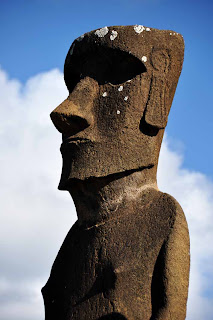
.JPG)
.JPG)
I slept in today, which was nice for a change after two consecutive days of waking up before 6:00 to try to catch the sunrise. Since I didn’t have my scooter to rush around the island with, I decided it would be a good idea to hike along the coast North of Hanga Roa for an hour or two. Steve and Debbie, the couple from my hotel who I explored Ranu Raraku with, told me about a cave they visited on that side of the island that was made entirely of lava rock. Hiking to the lava cave was a perfect way to spend my morning.
Cruising around the island on the scooter was definitely convenient, but it actually was nice just to spend a few hours walking to get a feel for things. I enjoyed watching horses graze in the distance and seeing the gigantic waves come into shore and crash against the black lava rocks below. The weather was perfect today, and after hiking for about an hour along a rugged dirt road, I finally came to a cairns that indicated the entrance to the lava cave.
When I first saw the opening to the cave I doubted I was in the right place because it was so small. A hole in the ground about two feet wide and three feet tall was all there was to crawl into, and after briefly looking around to see if there was any other entrance I decided to just go for it. Squeezing myself into the tiny hole was a bit of challenge, but the biggest challenge was finding my way around in the dark. I didn’t pack a flashlight with me, so all I had was the light from my iPod screen to guide me through the cave. The iPod couldn’t light up the whole cave in front of me, but if I pointed it directly at my feet as I crouched down I could see the just enough of the ground to walk. Fortunately the cave is only about a hundred feet long, and after a minute or two of walking with the iPod, there was enough light from the openings on the other end that I didn’t need it anymore.


The lava cave is called Ana Kakenga, but is also known as ‘The Cave of Two Windows’. At the end of the cave opposite from the tiny rocky entrance, two openings in the rock about six feet square let in bright beams of light from the outside and provide spectacular views of the coastline. I loved being the only one in the dark, mysterious lava cave and staring out of the openings down towering black lava cliffs, and across the bright blue ocean. I found a ledge next to one of the openings that was perfect for setting my camera on, so I took a few minutes to set the timer and take a picture of myself at the end of the cave.


I had to hike fast to make it back to Hanga Roa because I had arranged a scuba diving trip for 2:30 in the afternoon and left the cave at a little after 1:30. Fortunately I made to Mike’s Rapa Diving Center right at 2:31, and within minutes was in a small boat cruising out to the ocean. I had read in my guide book that the ocean water at Easter Island is known for being incredibly clear, so I was excited to try out the diving here. I descended into the water with a local guide and two Chilean travelers and spent about 45 minutes exploring Easter Island’s underwater world. The coral at the bottom of the ocean was shaped differently than any I’ve seen before, and I spotted a few spiny sea urchins and several long, thin fish that looked like a cross between a barracuda and an eel. Our guide led us through a couple of small caves at the bottom of the ocean, which was way fun, but to be perfectly honest, I’ve been to much better diving sites before. I definitely wouldn’t come to Easter Island just to dive, but it was a fun way to spend an afternoon, and it’s always great to get a feel for what diving is like in different parts of the world.
A couple of other travelers I met told me I absolutely had to see a ceremonial dance show while on Easter Island, so tonight I headed to a tiny venue on the coast that features a show called Matato’a. I loved Matato’a. For an hour and a half I watched from the second row as elaborately dressed Polynesian dancers performed animated war dances and hula-style dances to the beat of a rock band in the background that played guitars as well as ukuleles and bongo drums. I only had one small objection to the show: the male performers were very scantily dressed, and I felt a bit uncomfortable when they turned around to reveal completely exposed bottoms (except for a small piece of twine that held together a tiny loincloth). Altogether though, it was a great way to get a feel for the local music and culture, and the perfect way to spend my last day at Easter Island.
.JPG)





























